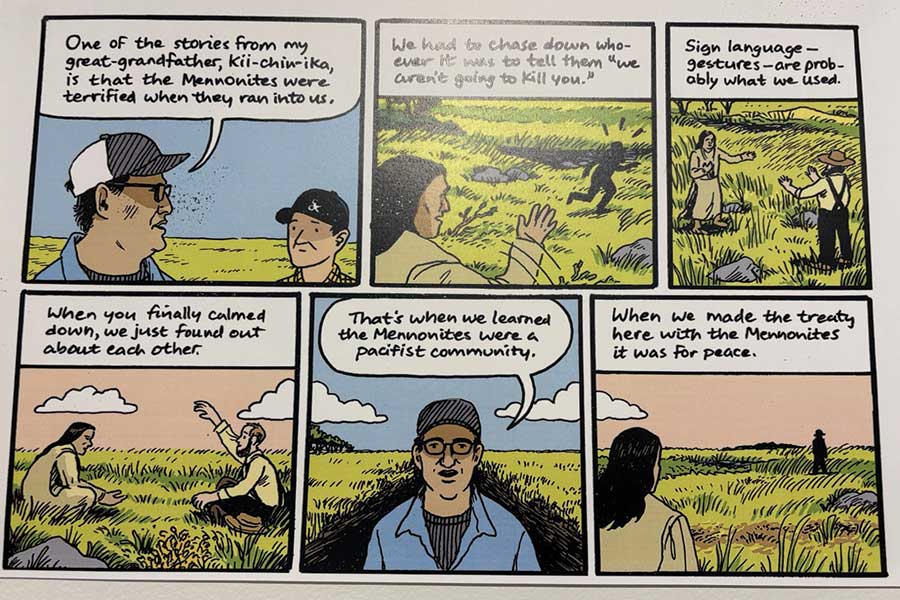An illustrated book project that delves into a little-known piece of cultural history is the subject of this month’s exhibit at the Pembina Hills Gallery in Morden.
The Secret Treaty speaks to the handshake treaty that is part of Indigenous tradition but not something widely known by others.
It revolves around Ojibwe stories from the land that Mennonites came to call the west reserve and stories of those early encounters between European newcomers and Indigenous peoples. Swan Lake First Nation knowledge keeper David Scott teamed up with artist-illustrator Johnathan Dyck, who is originally from Winkler, to create the graphic novel.
“I’ve been trying to get out these stories of how the different races that came here connected, and this was one of those stories because I’ve had lots of positive relationships with Mennonite people here,” Scott said at an exhibit opening last Wednesday.
He recalled the idea coming up in conversation with Will Braun, who had in the past been involved with organizations like the Truth and Action Working Group, and it was Braun who helped connect Scott with Dyck.
“And I finally found a way that we could get this story out,” said Scott. “It only took about 35 years, but, hey, it’s out in the world now.”
It was a remarkable and interesting opportunity for Dyck.
“I’ve been learning more about Mennonite history in the area, and I recognized that there were some major gaps and oversights,” he said. “There wasn’t much knowledge of the land, at least prior to the Mennonite settlement.”
He very much wanted to learn more about the area from a non-European perspective, so he was glad to be connected with Scott.
“He mentioned this story to me in passing at the Harvest Moon Festival,” recalled Dyck, who noted something was originally published about it in The Canadian Mennonite magazine.
The two cultures would perhaps be seen by many as being so different and disconnected, but Scott maintains that is not the case.
“There was connection I had made over the last 20 years or so with the Mennonite community particularly in Morden and the surrounding area,” he said. “It was purely by accident that we were able to get this story out … and I had tried to see if any Mennonite historian would help me publish it, but nobody wanted to talk about it 35 years ago … or even 30 years ago or 20 years ago.
“Times have changed,” he continued. “I was able to get together with Johnathan and say let’s get this story out there. I was very very happy when I saw the first drafts … and I thought that’s the way we need to tell this story.”
Dyck saw it as an important story that needed to be told.
“I think particularly in this area, growing up in Winkler, there was almost no mention of Indigenous peoples and that history of the land,” he said. “I think there was some awareness in Morden, but in Winkler, I don’t want to say it got swept under the rug, but it just didn’t get mentioned.
“I think the fact that it is in a visual format … you can tell the oral history a little differently that can be more engaging for people,” he said.
Since it came out a year ago, the book has received good feedback.
“They’re starting to use it in the schools more, and I’m working with eight school divisions now, so that keeps increasing,” Scott noted.
“For me, it was the kind of project I had been dreaming of,” said Dyck. “To be able to illustrate not just this history but also Dave sharing it with us out on the land. That was really special.
“I think there was also an educational mission with this project,” he added. “It was clear that we really wanted to get it out there.
“Coming from the settler perspective, I think it’s important for me and others to remember that things didn’t have to happen the way that they did and that relationships are still possible, and there is still work to do,” he concluded. “There is common ground, and there is also a common future that we have to figure out together.”
“I think the biggest takeaway from this for me is the story teaches us that our relationship was on the right path in the beginning,” observed Scott. “That part of our history was not out there.”

